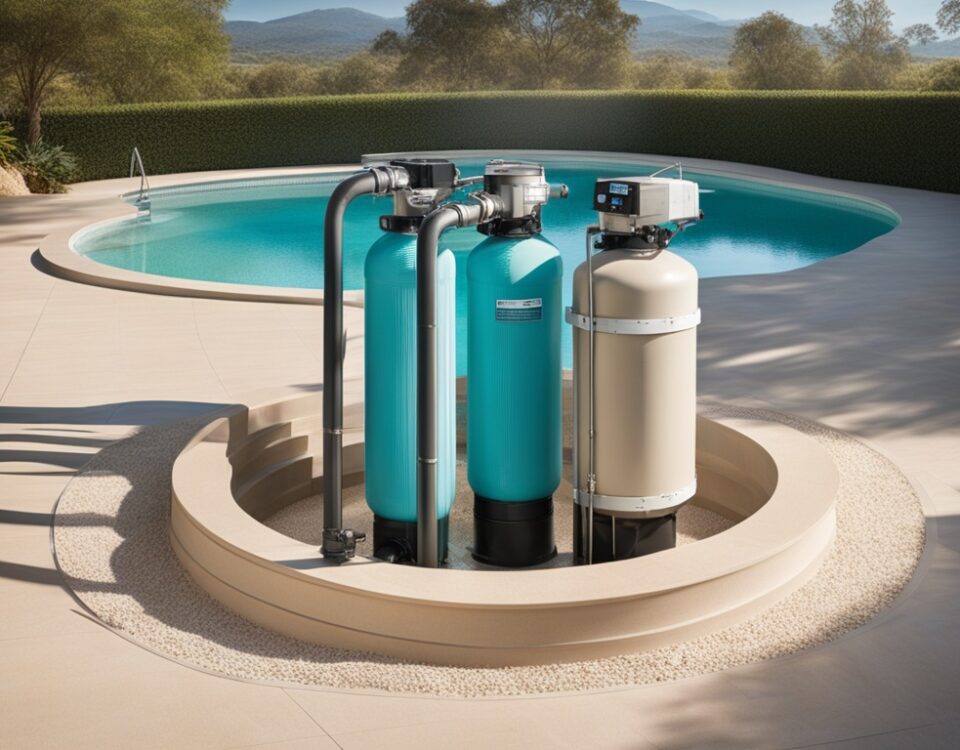Revolutionize Your Swim Season with Solar Pool Heating Systems!

Master the Art of Pool Cleaning: Your Ultimate Guide to Vacuuming Like a Pro!
May 3, 2025
Heat up Your Summer: Master the Art of Pool Heater Installation!
May 3, 2025Understanding Solar Pool Heating Systems
Solar pool heating systems utilize the sun’s energy to warm your swimming pool, offering an eco-friendly and cost-effective solution to extend your swimming season. These systems harness solar radiation through a series of solar collectors, typically installed on rooftops or ground-mounted, which capture sunlight and convert it into heat. This process involves circulating pool water through these collectors, allowing the water to absorb heat before it is returned to the pool.
How Solar Pool Heating Systems Work
The fundamental operation of solar pool heating systems is predominantly straightforward. When the pool pump is activated, water from the pool is drawn into the system and directed to the solar collectors. These collectors, which can be made from materials such as *polyethylene* or *EPDM rubber* (ethylene propylene diene monomer), efficiently absorb sunlight. As water flows through the collectors, it is heated by the sun’s rays. The heated water then returns to the pool, raising the overall temperature.
Many solar pool heating systems feature an integrated control system that optimizes the heating process. This system can assess the temperature of both the pool and the water arriving at the collectors, ensuring that only water that has reached a desired temperature is returned to the pool. By utilizing a *differential controller* or *automatic valves*, energy consumption is minimized while maximizing pool heating efficiency.
Benefits of Using Solar Energy to Heat Pools
One of the most compelling reasons to choose solar pool heating systems is their *sustainability*. Harnessing solar energy not only reduces your carbon footprint but also enables you to embrace a greener lifestyle. Moreover, swimming pools heated by solar energy reduce reliance on fossil fuels, ultimately contributing to a more sustainable future for the planet.
Additionally, solar pool heating reduces operational costs, as the system relies primarily on a free and renewable energy source: the sun. Compared to conventional gas or electric heaters, which can incur hefty utility bills, solar heating systems provide a significant reduction in energy expenses over time. A high-quality solar pool heating system can even yield savings of up to $1000 annually in heating costs, depending on regional sunlight exposure and pool usage.
| Key Benefits | Details |
|---|---|
| *Sustainable Energy Source* | Utilizes renewable solar power, reducing reliance on fossil fuels. |
| *Cost-Effective* | Significant reductions in heating expenses, saving up to $1000 annually. |
| *Extended Swimming Season* | Allows for comfortable swimming in cooler months or climates. |
| *Minimal Maintenance* | Generally requires less upkeep compared to conventional systems. |
Furthermore, the utilization of solar energy to heat pools promotes environmental stewardship. By decreasing the demand for traditional energy resources, these systems play a pivotal role in mitigating climate change. The integration of solar pool heating technology not only enhances your personal swimming experience but also contributes to a broader movement towards sustainability, aligning with contemporary environmental values.
Types of Solar Pool Heating Systems
When it comes to solar pool heating systems, various technologies are available, each tailored to meet different needs and preferences. Understanding these options is essential for homeowners seeking to maximize their pool’s warmth while minimizing their energy expenditures. Below, we delve into the main types of solar pool heating systems on the market.
1. Solar Panel Systems
Arguably the most popular choice, solar panel systems harness the power of the sun through a series of photovoltaic panels. These panels are typically made from durable materials like polycrystalline or monocrystalline silicon. They convert sunlight into heat, which is then transferred to the pool water circulating through the system. This method boasts a high efficiency rate, often exceeding 70%, making it a cost-effective option over the long term.
2. Solar Thermal Systems
Solar thermal systems operate on a slightly different principle, utilizing solar collectors to convert sunlight into thermal energy. Water is heated directly as it flows through these collectors, which can be flat-plate or evacuated tube designs. These systems are highly effective, particularly in warmer climates, providing efficiency ratings of 80% or more. Though generally more expensive to install than solar panel systems, their superior performance can lead to significant savings on energy bills over time.
3. Pool Cover Systems
Pool cover systems combine the principles of insulation and solar heating effectively. These covers, often transparent or translucent, trap heat during the day while also preventing heat loss during cooler nights. While they may not directly generate heat, they can raise pool temperatures by several degrees, enhancing the efficiency of traditional heating methods. As a supplementary option, they are relatively inexpensive and can lead to reduced energy costs when paired with other solar heating systems.
4. Solar Hot Water Systems
Solar hot water systems are another effective variant, using a set of roof-mounted solar collectors to generate hot water, which can then be diverted to heat the pool. These systems can be integrated into existing domestic water heating setups, allowing for versatile applications. While the efficiency can vary based on installation, they generally offer excellent performance, especially in areas with consistent daylight. However, upfront costs can be higher, necessitating a longer recovery period for return on investment.
5. Comparison Table
| Type of System | Efficiency | Initial Cost | Longevity |
|---|---|---|---|
| Solar Panel Systems | Up to 70% | Moderate | 15-20 years |
| Solar Thermal Systems | 80%+ | High | 15-25 years |
| Pool Cover Systems | Variable | Low | 5-10 years |
| Solar Hot Water Systems | Variable | High | 15-25 years |
When selecting a solar pool heating system, it is vital to consider both efficiency and cost-effectiveness. Each system varies not only in installation price but also in maintenance and longevity, thus leading to distinct long-term financial implications. For informed decision-making, homeowners should evaluate local climate conditions and their specific heating needs, ensuring optimal utility from their investment.
Installation and Maintenance of Solar Pool Heating Systems
Step-by-Step Guide to Installing a Solar Pool Heating System
Installing a solar pool heating system can be a rewarding undertaking, providing not only a more comfortable swimming experience but also enhancing energy efficiency. Follow this step-by-step guide to ensure a successful installation:
- Assess Your Pool Needs: Begin by determining your pool’s size and the amount of heat required. This will influence the number of solar panels you will need.
- Choose the Right Location: Select a sunny area for the solar panels, ideally with a south or southwest orientation. Ensure that there are minimal obstructions such as trees or buildings that could cast shadows.
- Gather Your Materials: You will need solar panels, a pump, a flow control valve, plumbing fittings, and mounting hardware. Consider investing in high-quality components to enhance durability.
- Mount the Solar Panels: Securely attach the panels to their designated location using the mounting hardware. Ensure they are angled correctly to maximize sun exposure.
- Connect the Plumbing: Install the plumbing connections between the solar panels and your pool’s filtration system. Use durable, UV-resistant piping to prevent degradation from sun exposure.
- Test the System: Before full operational use, check all connections for leaks. Ensure the pump is functioning correctly and that water circulates through the system efficiently.
Tips for Maintaining and Troubleshooting Common Issues
To keep your solar pool heating system operating optimally, regular maintenance is essential. Here are some valuable tips:
- Regular Inspections: Examine your solar panels monthly, looking for debris accumulation that can obstruct sunlight and reduce efficiency.
- Flush the System: Periodically flush the solar heating system to remove any build-up of mineral deposits, especially if you live in an area with hard water.
- Check for Leaks: Routinely inspect all connections and pipes for leaks. A small leak can lead to significant water loss and reduced efficiency.
- Monitor Performance: Keep an eye on the water temperature. If you notice less than expected heating, assess whether panels are receiving adequate sunlight or if system components require servicing.
- Professional Maintenance: Consider scheduling an annual inspection with a qualified technician to ensure all components function optimally, thus extending the life of your system.
| Common Issues | Signs | Troubleshooting Steps |
|---|---|---|
| Insufficient Heating | Water remains cool | Check for shading on panels, clean debris, and ensure proper flow rate. |
| Leaks in the System | Water pooling around connections | Inspect joints and fittings; tighten loose connections or replace faulty parts. |
| Pump Failure | No flow of water | Check power supply, ensure priming, and clear any obstructions in the impeller. |
Maximizing the Efficiency of Solar Pool Heating Systems
When it comes to achieving optimal performance from your solar pool heating system, several strategies can be employed to enhance efficiency and lower energy costs. By implementing these measures, pool owners can enjoy a consistently warm swimming experience while promoting environmentally friendly practices.
1. Strategic Placement of Solar Collectors
The location and orientation of solar collectors significantly influence their effectiveness. Ideally, collectors should be installed on a south-facing slope, free from shade during peak sunlight hours. Positioning these collectors at an angle that corresponds to your geographical latitude can maximize solar gain. Furthermore, ensure that obstructions such as trees, buildings, or fences do not obstruct sunlight, as even partial shading can drastically reduce the system’s efficiency.
2. Utilize a Solar Cover
Employing a solar cover can be one of the simplest yet most effective ways to enhance the efficiency of your heating system. A solar cover not only assists in retaining heat generated during the day but also minimizes evaporation—an often-overlooked contributor to heat loss. By reducing evaporation by up to 90%, a solar cover can significantly decrease heating costs and maintain a comfortable water temperature, especially during cooler evenings.
3. Optimize System Flow Rate
Adjusting the flow rate of water through your solar heating system can yield substantial performance improvements. An excessively high flow rate may reduce the time water spends in the collectors, diminishing the amount of heat absorbed. Conversely, a flow rate that is too low can lead to inadequate heating. Striking the right balance is critical. A common rule of thumb suggests maintaining a flow rate of approximately half a gallon per minute per square foot of solar collector area, ensuring maximum thermal efficiency.
4. Regular Maintenance and Cleaning
Like any mechanical system, regular maintenance is vital for the longevity and efficiency of solar pool heating systems. Periodic cleaning of solar collectors is essential, as dirt, debris, and mineral buildup can impede performance. A simple wash with a soft brush and mild soap can restore optimal function. Additionally, check for leaks and ensure that all connections remain secure. A well-maintained system operates more efficiently, reducing the need for costly repairs and replacements.
5. Incorporate Energy-Efficient Pumping Solutions
To further reduce costs and maximize energy savings, consider upgrading to an energy-efficient pump. Variable-speed pumps are particularly advantageous, as they adjust their operation based on the system’s needs. This feature allows for lower energy consumption during periods of lower demand. In fact, variable-speed pumps can achieve up to 80% energy savings compared to traditional single-speed pumps, contributing significantly to the overall efficiency of your solar pool heating system.
6. Monitor and Adjust Operating Times
Being strategic about when to operate your solar heating system can greatly influence overall energy consumption. Operating the system during the sunniest hours of the day ensures maximum thermal absorption. Installing a timer or smart control system can help automate this process, making it easier to optimize heating schedules based on weather patterns and pool usage. This proactive approach will reduce unnecessary energy expenditure while maximizing the benefits of solar heating.
| Strategy | Potential Energy Savings |
|---|---|
| Solar Cover Usage | Up to 90% reduction in evaporation |
| Optimized Flow Rate | Improved heat retention |
| Energy-Efficient Pumping | Up to 80% energy savings |
| Regular Maintenance | Increased system lifespan and efficiency |
Environmental Impact of Solar Pool Heating Systems
In an era where environmental sustainability is paramount, the adoption of solar pool heating systems has emerged as a groundbreaking solution for swimming pool owners seeking eco-friendly alternatives. By harnessing the *untapped power of the sun*, these systems utilize renewable energy to maintain optimal water temperatures, significantly reducing reliance on fossil fuels and lowering greenhouse gas emissions.
Eco-Friendly Benefits of Using Solar Energy
One of the most compelling advantages of solar pool heating is its almost negligible impact on the environment. Unlike conventional methods relying on natural gas or electricity generated from non-renewable sources, solar systems dramatically decrease *carbon footprints*. By converting solar radiation into usable thermal energy, these systems produce *zero emissions*, allowing pool owners to enjoy their aquatic retreats while contributing to a cleaner planet.
Furthermore, solar pool heaters significantly reduce energy consumption, providing an efficient alternative that not only lowers utility bills but also aids in the conservation of precious resources. The implementation of solar technology helps mitigate the demand for fossil fuels, aligning domestic recreational activities with broader global efforts to combat climate change.
Comparative Analysis of Carbon Footprint
To concretely illustrate the environmental advantage of solar pool heating systems, a comparison of their carbon footprint with that of traditional heating methods can be insightful. The following table showcases the estimated annual carbon emissions associated with different pool heating systems:
| Heating Method | Annual Carbon Emissions (lbs) |
|---|---|
| Solar Pool Heating | 0 |
| Natural Gas Heating | 1,500 |
| Electric Heat Pump | 2,000 |
| Electric Resistance Heater | 3,200 |
From the data presented, it is evident that *solar pool heating systems* stand in stark contrast to their conventional counterparts, producing *no emissions* at all, while natural gas and electric systems contribute significantly to the carbon footprint. This metric highlights the profound environmental benefits associated with solar energy utilization in backyard pools.
Additionally, the longevity and minimal maintenance of solar heating systems further enhance their sustainability. With an average lifespan exceeding 20 years, these systems not only represent a wise financial investment but also emphasize *responsibility towards the environment*. By choosing solar technology, pool owners can effectively support a shift towards a more sustainable future while enjoying the pleasures of warm water relaxation.
Financial Incentives for Installing Solar Pool Heating Systems
In the realm of eco-friendly investments, solar pool heating systems stand out not only for their capacity to enhance the swimming experience but also for the significant *financial savings* they offer. Various rebates, tax credits, and incentives exist to encourage homeowners to embrace renewable energy, particularly solar technology. Individuals considering such an investment should delve into the plethora of available financial support programs that can offset installation costs and expedite return on investment.
Available Rebates and Tax Credits
Many states and local governments offer *rebates* specifically aimed at reducing the cost of solar pool heating system installations. These rebates can vary substantially by region, often covering a percentage of the installation costs or providing a fixed dollar amount. It’s essential to investigate local programs, as many municipalities are eager to incentivize solar adoption to decrease reliance on conventional energy sources. Additionally, the federal government offers a *Solar Investment Tax Credit (ITC)* that allows homeowners to deduct a significant portion of the installation costs from their federal tax returns. Currently, this credit stands at a robust 26%, decreasing to 22% in the coming years, making now an opportune time to invest.
Incentives by State and Utility Companies
Beyond federal and local government incentives, utility companies often have their own *financial assistance programs* for solar installations. Many of these companies recognize the long-term benefits of reducing energy demand and may provide rebates or performance-based incentives for homeowners who install solar pool heating systems. In some cases, utilities even offer low-interest financing options to facilitate the transition to solar energy. By researching your specific utility provider’s programs, homeowners can discover unique offers that might significantly reduce initial costs.
Maximizing Savings with Financial Assistance Programs
To truly capitalize on these financial incentives, homeowners should approach their solar purchase with a strategic mindset. *Conducting thorough research* is paramount; this includes not only investigating the rebates and credits available but also comparing multiple contractors to find competitive pricing. When seeking quotes, inquire about additional opportunities for savings, such as manufacturer rebates or referral discounts from local installers.
Tax Planning and Long-term Considerations
It’s prudent to coordinate the timing of your solar pool heating system installation with your overall tax strategy. *Consulting a tax professional* can provide insights into how best to utilize the Solar Investment Tax Credit and ensure that you are positioned to benefit maximally from these incentives. Furthermore, consider the longevity of the system; over time, the cumulative savings on energy bills, alongside available financial incentives, can result in significant returns, making solar installations not just an environmentally friendly choice, but a financially sound investment as well.
| Type of Incentive | Description | Potential Savings |
|---|---|---|
| Federal Solar Tax Credit (ITC) | Deduction of installation costs from federal taxes | Up to 26% of installation costs |
| State Rebates | Direct rebates from state governments | Varies by state (typically $1,000 – $5,000) |
| Utility Company Incentives | Rebates or financing options from local utility providers | Varies widely; often $500 – $3,000 |
Case Studies and Success Stories of Solar Pool Heating Systems
Real-Life Installations: Transforming Swimming Experiences
The implementation of solar pool heating systems has profoundly enhanced the swimming experiences of numerous homeowners. For instance, the Martin family from California installed a solar heating system last summer, resulting in a consistent water temperature rise of up to 10°F. They report nearly doubling their pool usage, turning their backyard into a year-round recreation oasis. This installation not only facilitated extended swimming seasons but also facilitated a 40% decrease in energy costs compared to traditional heating options.
Customer Satisfaction: Testimonials from Happy Swimmers
One of the most compelling aspects of solar pool heating is the satisfaction it elicits from users. The Thompson couple, who reside in Arizona, shared their delight with the solar heating system installed in their backyard. “We used to dread the chilly water when swimming in early spring,” remarked Mrs. Thompson. “Now, our pool feels inviting all year round.” Their positive experience highlights how solar heating can maximize enjoyment while minimizing energy expenditure.
Quantifiable Benefits: Comparative Energy Savings
| Heating Method | Annual Energy Cost ($) | Carbon Footprint (CO2 E)* |
|---|---|---|
| Traditional Gas Heater | $1,200 | 2,000 lbs |
| Electric Heat Pump | $800 | 1,200 lbs |
| Solar Pool Heating | $300 | 0 lbs |
This table succinctly illustrates the *cost-effectiveness* and *environmental sustainability* of solar pool heating. Homeowners can realize not only substantial financial savings but also significantly reduce their carbon footprint, further contributing to a cleaner planet. Such data resoundingly affirms the advantages of making the transition to solar technology.
Success Stories: Community-Wide Initiatives
Beyond individual case studies, many community pool facilities have transitioned to solar heating, serving as beacons of sustainable practices. The local recreation center in Clearwater, Florida, successfully equipped its Olympic-sized pool with a state-of-the-art solar heating system. Not only did this shift achieve an impressive 65% reduction in heating costs, but it also increased the pool’s utilization by visitors eager to enjoy the warm water. Overwhelming positive feedback from community members showcases the collaborative benefits of adopting solar heating solutions.
The Ripple Effect: Inspiring Neighboring Homes
Another remarkable outcome of successful solar pool heating installations is the *ripple effect* on nearby homes. The Gonzalez family, who opted for a solar pool heating system, reported that their experience encouraged three neighboring households to follow suit. This communal adoption leads to a vibrant *green* transformation in their neighborhood, fostering environmental consciousness and community engagement. The satisfaction expressed by these families illustrates the broader impact solar heating has on lifestyle choices and environmental responsibility.
Long-Term Performance and Reliability
A key element in the success of solar pool heating systems is their long-term performance and reliability. The O’Connor family from New Jersey installed their system five years ago, and they have since experienced minimal maintenance issues and consistent efficiency. “We often forget about the system because it works so well,” noted Mr. O’Connor. With *innovative technology* and reliable manufacturing, these systems are designed to endure the elements, offering homeowners peace of mind along with financial benefits, thereby reinforcing the credibility of solar pool heating as a sustainable choice.
Learn more about Swimming Pool

Javier Morales is passionate about pool design, maintenance, and outdoor living. With years of hands-on experience, he offers practical tips, creative ideas, and expert insights to help readers make the most of their pool spaces. At Piscina Planet, Javier shares everything from seasonal care guides to the latest trends in pool innovation.




